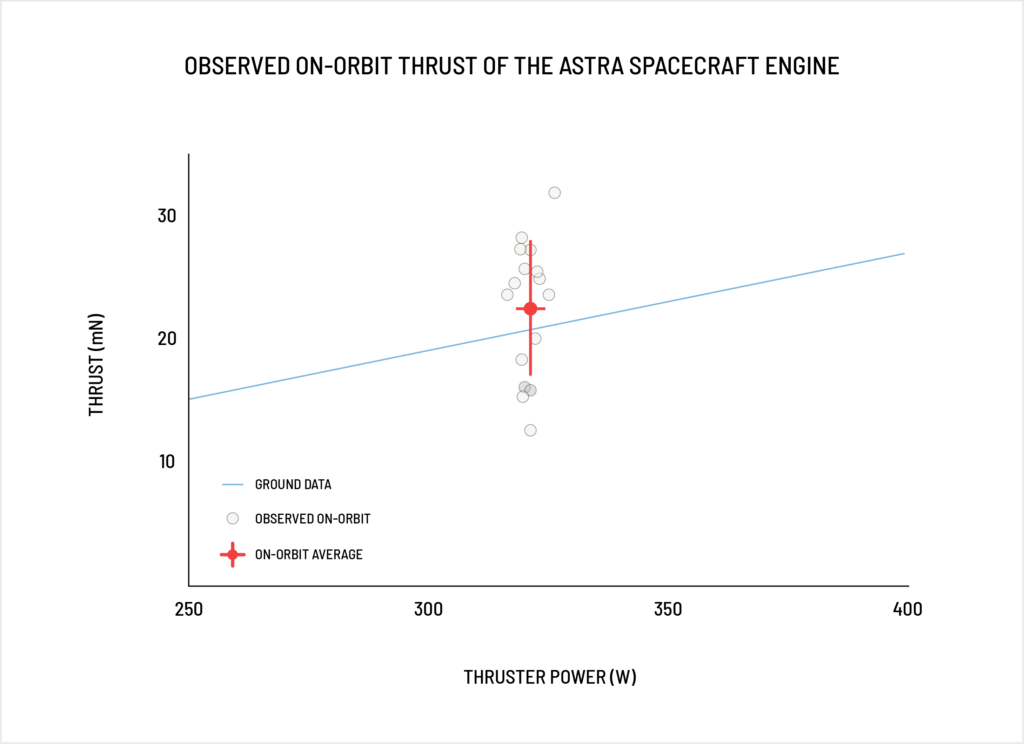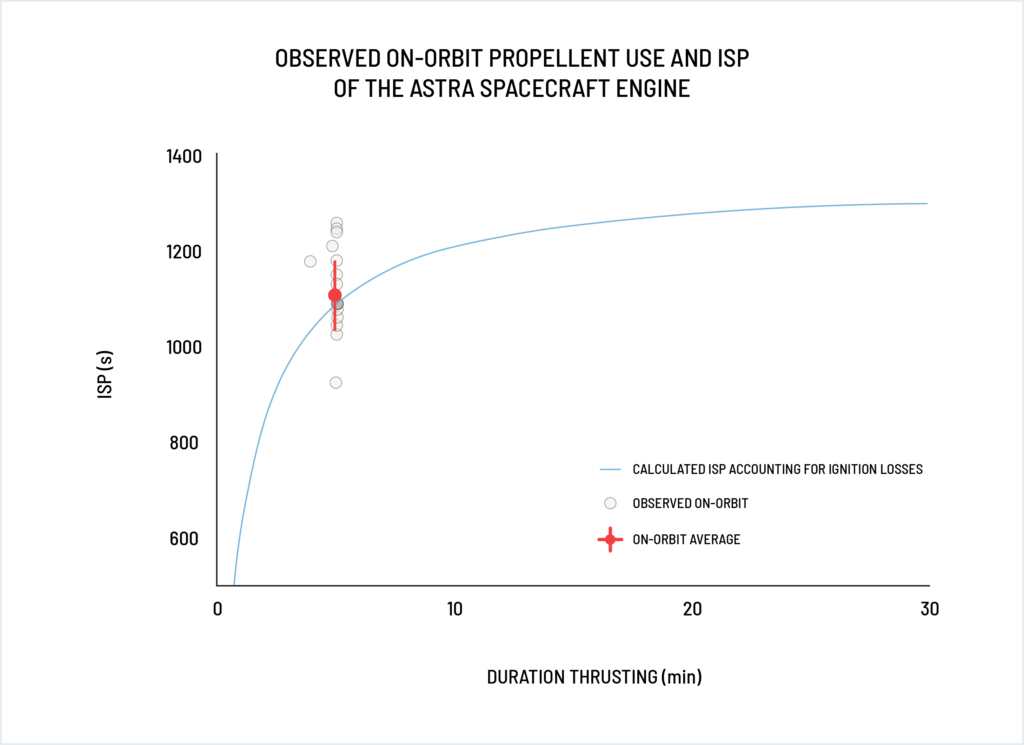By Matthew Gill PhD, Senior Systems Engineer
The first Astra Spacecraft Engine™ reached orbit on June 30, 2021 aboard Spaceflight’s Sherpa-LTE all-electric Orbital Transfer Vehicle (OTV) on the Spaceflight Sherpa-LTE1 SXRS-5 mission. After several weeks of Sherpa-LTE commissioning — spacecraft checks to make certain everything is working as planned — the electric propulsion system ignited on its first attempt on August 20, 2021 and recently surpassed its 300th on-orbit burn. In this piece, we’ll take a look at the observed on-orbit data that demonstrates the propulsion system’s consistent on-orbit performance, to date.
Today, on-orbit propulsion and mobility are important components of safe, economical, and effective space services. Whether raising to a different orbit from initial insertion, executing collision avoidance, or ensuring that a constellation is adequately equipped for responsible end-of-life operations, an efficient and reliable on-orbit propulsion system is a mission-critical system aboard any spacecraft.
The Astra Spacecraft Engine™ (ASE) is a fully-integrated electric propulsion system that consists of a Hall-effect thruster (HET), a pneumatic feed system, radiation-hardened (rad-hard) electronics, and a composite over-wrapped pressure vessel (COPV) tank that can be shipped to a launch site fully fueled. Astra handles all aspects of design, integration, and testing for shipping and launching a propulsion system. The system uses the same space-qualified components for each customer to meet each customer’s specific mission requirements. Each module can be configured with multiple thrusters if desired and various tank sizes to support a broad range of missions including low Earth orbit (LEO) raising, medium Earth orbit (MEO) raising, geostationary orbit (GEO) raising, station keeping, cis-lunar transfers, and de-orbiting. Prior to flight, the propulsion system undergoes a battery of ground tests including vibration, shock, thermal, pressure, and leak testing. The full system is hot fire tested, with performance measured for comparison to on-orbit operations.
ON-ORBIT DATA FOR SPACEFLIGHT’s Sherpa-LTE1 Mission
While the Astra Spacecraft Engine™ had undergone thousands of hours of component and system-level ground testing prior to its initial flight, Spaceflight’s Sherpa-LTE1 mission was the first time the system was tested on-orbit. The integration, testing, and qualification of a propulsion module has inherent difficulties that go beyond demonstrating individual subsystems, and this mission gave Astra the opportunity to demonstrate the process of successful delivery, launch, and operation of an integrated propulsion module in orbit.
With the goal of quickly demonstrating the on-orbit performance of the Astra Spacecraft Engine™, our team developed the propulsion module from concept to testing to hardware delivery in 6 months. Although Astra’s Spacecraft Engine is designed for standard operation at 400 Watts (W), the rapid development of the Sherpa-LTE1 mission meant that the power management system had to be smaller, as such, the system was operated at 340 W for 5-minute thrust durations. Working at a reduced power still allowed for repeatable (over 300) system demonstrations and progress towards de-orbiting of the satellite.
Average performance on-orbit has been within one standard deviation of ground test data — which is a validation of both the system performance as well as a validation of the ground test facilities and processes used to test its integrated propulsion systems. Full system hot fire tests were performed pre- and post-dynamics testing, and data from operating the flight module on the ground was used for comparison to on-orbit operations. Due to limited capacity to downlink data, data has only been downloaded for a subset of activations as discussed below. Altitude change and propellant usage were used to derive thrust and specific impulse.
OBSERVED ON-ORBIT THRUST
The observed thrust on-orbit was calculated using Sherpa’s GPS data. Due to the relatively small change in altitude from 5-minute thruster operations, the measurement error is large. As such, it is not possible to get high accuracy thrust estimates from individual maneuvers, but the average of multiple measurements is representative.
In Figure A, the blue line shows average thruster performance as a function of power, from ground test data. The gray points show observed on-orbit thrust. The red point shows the average of on-orbit thrust measurements with one standard deviation. The mean on-orbit thrust is within one standard deviation of the expected value, which validates the ground testing thrust performance set.

Note: On-orbit thrust has a large standard deviation due to measurement errors when performing short duration maneuvers, rather than variability in thruster performance. Based on thousands of hours of ground testing, there is extremely low variability of the thruster performance between multiple ground test firings.
OBSERVED ON-ORBIT PROPELLENT USE AND ISP
Rad-hard telemetry data sets were used to calculate on-orbit specific impulse (Isp) or thrust produced per gram of propellant used and were compared to average ground test data. As a result of activation losses (when some propellant flows during activation but does not produce thrust until the thruster turns on), the effective Isp for a maneuver is dependent on the maneuver duration. Longer maneuvers have higher Isp. The black line below shows the impact of activation losses on Isp. Note, due to schedule constraints, the feed system used for the Sherpa demonstration is an early engineering model (EM) and has higher activation losses compared to our current optimized production designs.
In Figure B, the blue line shows expected Isp as a function of maneuver duration. The grey points show observed on-orbit Isp for the 5-minute maneuvers. The red point shows the average of on-orbit Isp with one standard deviation. The mean on-orbit Isp is within one standard deviation of the expected value, again validating the thrust performance set from ground testing.

Note: Isp is lower than the “steady state” Isp quoted due to activation losses which are disproportionately high for short-duration maneuvers (some propellant flows during activation but does not produce thrust until the thruster turns on), between 15 and 20 minutes the Isp approaches the steady state value.
In Figure C, the summary table shows that on-orbit performance is within one standard deviation of ground test data, validating the on-orbit performance of ASE.

Note: System efficiency is the total efficiency, accounting for housekeeping circuits, feed system power, and circuit efficiency.
The Sherpa-LTE1 propulsion system has fired over 300 times and continues to operate on orbit. Operations have been consistent, repeatable, and match ground test data. Click here for a full technical overview of the Astra Spacecraft Engine™.